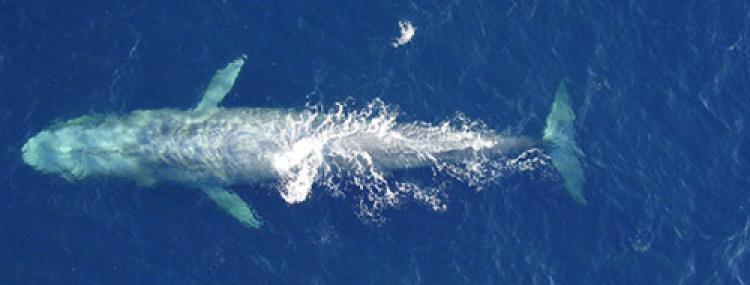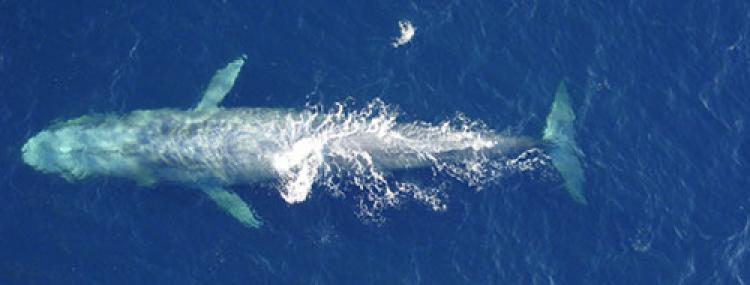The pitch of blue whale songs around the world has been lowering for the past few decades, and scientists think that it may indicate an increase in the population of this endangered animal, which was commercially hunted until 1972.
Studying blue whale song data from the Southern California coast to the Indian and Southern Oceans, Mark McDonald of WhaleAcoustics, John Hildebrand of Scripps Oceanography, and Sarah Mesnick of NOAA Fisheries Southwest Fisheries Science Center discovered a downward curve in the pitch, or frequency, of the songs.
“The best documented song type, observed offshore California, now is sung at a frequency 31 percent lower than it was in the 1960s,” they wrote in their research paper. “Worldwide Decline in Tonal Frequencies of Blue Whale Songs,” published in the journal Endangered Species Research.
“The basic style of singing is the same, the tones are there, but the animal is shifting the frequency down over time. The more recent it is, the lower the frequency the animal is singing in, and we have found that in every song we have data for,” said Hildebrand in a press release.
While the function of blue whale songs is uncertain, researchers do know that all singers are males. Since blue whales are widely dispersed during the breeding season, it is probable that the songs serve to advertise and locate the singer.
The researchers examined a list of possible causes for the frequency drop, including social learning, increasing ocean noise, increasing whale body size, global warming, interference from other animal sounds, and increasing anthropogenic noise. They concluded that “none of the commonly suggested hypotheses were found to provide a full explanation,” but believe the increased population of blue whales is the closest explanation.
According to the researchers, when blue whale population was low during the peak of commercial whaling, male blue whales probably sang at higher frequency in order to maximize their transmission distance and their ability to communicate with conspecifics.
“It may be that when [blue whale] densities go up, it’s not so far to get to the closest female; whereas back when they were depleted, it may have been that the closest female was a long way away,” said Hildebrand.
The scientists say that the same downward pitch phenomenon may be true in other whales such as fin and humpbacks, but the blue whale song, with a comparatively easier song to analyze, is a good springboard for studying other species.
During the study, the researchers analyzed thousands of blue whale songs divided into at least 10 regions. Blue whale songs have been recorded for the last 45 years through scientific and military applications by seafloor seismometers tracking regional earthquakes and dedicated whale acoustic recording packages.
Read the research paper
Studying blue whale song data from the Southern California coast to the Indian and Southern Oceans, Mark McDonald of WhaleAcoustics, John Hildebrand of Scripps Oceanography, and Sarah Mesnick of NOAA Fisheries Southwest Fisheries Science Center discovered a downward curve in the pitch, or frequency, of the songs.
“The best documented song type, observed offshore California, now is sung at a frequency 31 percent lower than it was in the 1960s,” they wrote in their research paper. “Worldwide Decline in Tonal Frequencies of Blue Whale Songs,” published in the journal Endangered Species Research.
“The basic style of singing is the same, the tones are there, but the animal is shifting the frequency down over time. The more recent it is, the lower the frequency the animal is singing in, and we have found that in every song we have data for,” said Hildebrand in a press release.
While the function of blue whale songs is uncertain, researchers do know that all singers are males. Since blue whales are widely dispersed during the breeding season, it is probable that the songs serve to advertise and locate the singer.
The researchers examined a list of possible causes for the frequency drop, including social learning, increasing ocean noise, increasing whale body size, global warming, interference from other animal sounds, and increasing anthropogenic noise. They concluded that “none of the commonly suggested hypotheses were found to provide a full explanation,” but believe the increased population of blue whales is the closest explanation.
According to the researchers, when blue whale population was low during the peak of commercial whaling, male blue whales probably sang at higher frequency in order to maximize their transmission distance and their ability to communicate with conspecifics.
“It may be that when [blue whale] densities go up, it’s not so far to get to the closest female; whereas back when they were depleted, it may have been that the closest female was a long way away,” said Hildebrand.
The scientists say that the same downward pitch phenomenon may be true in other whales such as fin and humpbacks, but the blue whale song, with a comparatively easier song to analyze, is a good springboard for studying other species.
During the study, the researchers analyzed thousands of blue whale songs divided into at least 10 regions. Blue whale songs have been recorded for the last 45 years through scientific and military applications by seafloor seismometers tracking regional earthquakes and dedicated whale acoustic recording packages.
Read the research paper






